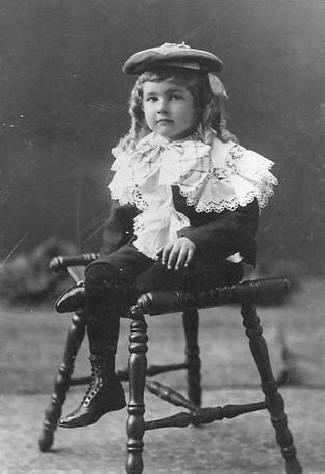
Figure 1.--This San Jose, California boy wears an elaborate Fauntleroy blouse. His large ruffle collar has cut-out lace worked into it. He wears a tam with his Fauntleroy suit. The portrait is undated, but looks to hve been taken about 1905. |

|
We note elaborate lace collars done as part of a blouse. There were various collar shapes. Some were done with sailor styling with "V"s and back flaps. Some were square. Others were in various other shapes. We note rounded collars as well as star-shaped collars with various shapes and numbers of rays. These were especially popular with cut-away jackets, the jacket style used in the classic Fauntleroy suit. These blouse collars were done in many different sizes and shapes. This varied substantially over time. The lace coolar blouses were most popular in the 1880s and 90s, but we see them before nd after this period. The larger collars were less likely to be pure lace collars, but many had some lace worked into them, often in the edging. Others had only a small anount of lace, usually a lace trim or edgeding to a larger collar. A good example of edging is Joe Meyers. We note them being worn with and without floppy bows. Its somewhat difficult to be sure about the coubstruction of these blouses. , but we think mot of the garments worn with open cut-away jackets were blouses with attached collars.
This varied substantially over time. The lace collar blouses were most popular in the 1880s and 90s, but we see them before and after this period, although not nearly as commonly. Before the 1880s and after about 1905 they were smaller. We note ruffled collars becoming more popular in the 1890s.
We note elaborate lace collars done as part of a blouse. Its somewhat difficult to be sure about the construction of these blouses, but we think mot of the garments worn with open cut-away jackets were blouses with attached collars. I am not entirely sure how they were attached. It may not have been as permanely as is the case for modern shirts and blouses.
We note various types of lace being used on these lace collar blouses. We see both proper lace and eyelet lace, which despiye the nme was not a proper type of lace.
There were various collar shapes. Some were done with sailor styling with "V"s and back flaps. Some were square. Others were in various other shapes. We note rounded collars as well as star-shaped collars with various shapes and numbers of rays. The number of different shaps as well as the possible variarions on eah shape and the various types of lace means there was a very large number different shaped lace collars. The collars could ve scalloped or smooth edged.
The shapes of the collars on Fauntleroy blouses could be quite different in the front and back. This was not the case as much for the oin-on lace collars. Many Fauntleroy blouses were done with collars that had back flaps like sailor suits. They were not sailor collars, but had the back flaps anyway. I'm not sure just why this was. I think it probably reflected the great popilarity of sailor styles. Some sailor outfits, mostly sailor tunics, were done with lace trim, but the Fauntleroy blouse was an entirely different style. We are not yet sure just how popular the back flaps were, but think that they were fairly common. They were mostly done with lace or ruffled trim around the edges. We think some of the backs were more rounded, but am not yet sure about this. Images showing the backs are fairly rare as mothers understandably wanted their voys to face forward in formsl studio portraits.
Lace collar blouse were done in many different sizes. We see very small collars that were barely visible in old portrais. And we see lace collars that seem to engulf small boys. The larger collars in relative termswere reserved for the younger boys. The larger collars were less likely to be pure lace collars, but many had some lace worked into them, often in the edging. Others had only a small anount of lace, usually a lace trim or edgeding to a larger collar. A good example of edging is Joe Meyers. Generally the largest collrs were ruffled collars. Lace could be quite expenive, but gthis of course depended on the quality of the lce. It was thus possible to make a more modestly priced large collar as a ruffled collar than a lace collar. Of course younger children are so small that they can have what looks like a very large collar, but does not use as much lace as would be used on a small adult collar.
We note boys wearing lace collar blouses both with and wihout neckwear. The most common neckwear seems to have been floppy bows, but there were other types. It was more common to see bpys weraring lace collar blouse with neckwear, but we notice quite a number of portraits showing boys wearing these blouses sithout ndeckwear as well.
These were especially popular with cut-away jackets, the jacket style used in the classic Fauntleroy suit.
Navigate the Historic Boys' Clothing Web dress pages:
[Return to the Main U.S. lace collar typepage]
[Return to the Main U.S. collar style page]
[Return to the Main ruffled collar page]
[Return to the Main shirts page]
[Return to the Main U.S. garment page]
[Tams]
[Floppy bows]
[Fauntleroy suits]
[Floppy bows]
[Knee pants]
[Long stockings]
[Ringlet curls]
Navigate the Boys' Historical Clothing Web Site:
[Introduction]
[Activities]
[Biographies]
[Chronology]
[Clothing styles]
[Countries]
[Bibliographies]
[Contributions]
[Essays]
[FAQs]
[Glossaries]
[Images]
[Links]
[Registration]
[Tools]
[Boys' Clothing Home]
